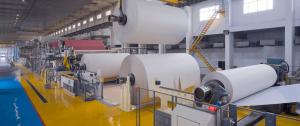United States Pulp and Paper Market Set to Reach USD 69.33 Billion by 2034 | MRFR
The United States Pulp and Paper market segmentation, based on Category, includes Wrapping & Packaging, Printing & Writing, Sanitary, News Print, and Others.
NEW YORK, NM, UNITED STATES, April 29, 2025 /EINPresswire.com/ -- The United States Pulp and Paper Market is transforming in response to environmental imperatives, digital disruption, and shifting consumer demands. While traditional segments face decline, emerging opportunities in packaging, hygiene, and specialty applications offer new paths for growth. Sustainability, innovation, and adaptability will be the cornerstones of a resilient future for this vital industry. The pulp and paper industry in the United States is a longstanding pillar of the nation's manufacturing base. Although it faces headwinds from environmental pressures and digital disruption, the industry remains resilient due to its critical role in packaging, hygiene, and specialty paper markets. In an era increasingly defined by sustainability and digitization, the U.S. pulp and paper market is undergoing structural transformations to adapt to new consumer behaviors, regulatory landscapes, and technological innovations.The United States Pulp and Paper Market Size was valued at USD 62.75 Billion in 2024. The Pulp and Paper industry is projected to grow from USD 63.38 Billion in 2025 to USD 69.33 Billion by 2034, exhibiting a compound annual growth rate (CAGR) of 1.00% during the forecast period (2025 - 2034).
Key Market Segments
1. Packaging Paper
One of the most dynamic areas within the U.S. pulp and paper market is packaging. With the continued rise of e-commerce, food delivery, and consumer preferences for sustainable and recyclable materials, packaging paper has seen a robust surge in demand. Corrugated boxes, kraft paper, and paperboard are widely used in shipping, retail, and industrial applications.
Packaging paper is valued for its strength, recyclability, and versatility. Companies across industries are replacing plastic with fiber-based alternatives, accelerating the shift toward paper-based packaging solutions.
2. Tissue and Hygiene Products
Tissue and hygiene paper—such as toilet paper, paper towels, and facial tissues—represent a steady and essential market segment. These products are relatively insulated from digital disruption and maintain consistent demand due to their necessity in both residential and commercial settings.
Consumer preferences have evolved to favor soft, durable, and sustainably produced tissue products. Manufacturers are responding by improving fiber quality, incorporating recycled content, and reducing environmental footprints during production.
3. Printing and Writing Paper
Once the backbone of the pulp and paper industry, printing and writing paper have experienced a sharp decline. The transition to digital communication, remote work, and paperless offices has reduced demand for products like copier paper, newsprint, and magazines.
While this segment continues to shrink, it remains relevant for specific uses such as legal documentation, education, and creative publishing. However, ongoing capacity reductions and mill closures reflect the irreversible trend toward digitization.
Get Free Sample Copy of United States Pulp and Paper Market Report @ https://www.marketresearchfuture.com/sample_request/20706
Market Drivers
1. Rise of E-Commerce
The expansion of online shopping has significantly impacted the demand for corrugated and protective packaging. The need for efficient, eco-friendly packaging solutions for shipping has led to widespread adoption of paper-based products.
This trend is not only reshaping the packaging paper segment but also encouraging investments in lightweight, high-strength materials that reduce shipping costs and environmental impact.
2. Focus on Sustainability
Environmental awareness among consumers and businesses is transforming the pulp and paper industry. Paper products are increasingly viewed as a sustainable alternative to single-use plastics, particularly in food packaging and retail.
The industry is responding by adopting sustainable forestry practices, increasing recycled fiber content, and reducing emissions and water usage during production. These practices are not only regulatory requirements but also key competitive advantages in the modern market.
3. Hygiene and Health Awareness
Tissue and hygiene products received a demand boost during the health crisis and have maintained elevated consumption levels. The heightened awareness of personal hygiene has led to increased use of disposable paper products in homes, healthcare settings, and commercial facilities.
As hygiene continues to be prioritized, especially in public spaces, demand for these products remains strong, fueling steady production levels and innovation in softness, absorbency, and biodegradability.
Buy Now @ https://www.marketresearchfuture.com/checkout?currency=one_user-USD&report_id=20706
Challenges Facing the Industry
1. Environmental Regulations
The pulp and paper industry is highly regulated due to its use of natural resources and emissions. Compliance with air and water quality standards, sustainable forestry laws, and emerging regulations around deforestation and traceability presents significant operational challenges.
Adapting to stricter environmental regulations—both domestic and international—requires investment in cleaner production technologies and transparent supply chains.
2. Raw Material Costs and Supply Chains
The availability and cost of raw materials—particularly wood pulp—can fluctuate due to weather events, trade policies, and labor constraints. Supply chain disruptions can lead to production delays and increased input costs, affecting pricing and profitability.
Efforts to diversify sourcing, use recycled fibers, and invest in local fiber supply chains are part of the industry’s strategy to mitigate these risks.
3. Market Saturation and Overcapacity
In certain product categories, especially printing and writing papers, overcapacity remains a challenge. Declining demand combined with legacy infrastructure leads to underutilized mills and profit erosion. Strategic closures, capacity realignments, and investment in higher-growth segments are ongoing responses to this issue.
4. Competition from Alternative Materials
Despite growing demand for sustainable materials, paper products face competition from innovations in compostable plastics, bio-based materials, and reusable alternatives. The challenge for the pulp and paper industry is to remain cost-effective while continuously improving the environmental footprint of its products.
Key Players in the US Pulp and Paper Companies include:
International Paper (U.S.)
Georgia-Pacific Corporation (U.S.)
WestRock (U.S.)
Packaging Corporation of America (U.S.)
Domtar Inc. (U.S.)
Graphic Packaging International (U.S.)
Verso Corporation (U.S.)
Resolute Forest Products (Canada)
Sappi Ltd. (U.S.)
Kimberly-Clark Corporation (U.S.)
Read More about this Report @ https://www.marketresearchfuture.com/reports/usa-pulp-paper-market-20706
Future Outlook
The U.S. pulp and paper market is expected to experience modest growth over the next decade, largely driven by shifts in consumer behavior and industrial demand. Packaging and hygiene applications will continue to lead the way, while printing and writing papers decline further. Meanwhile, the specialty paper segment will offer opportunities for high-margin growth through customization and performance enhancements.
Sustainability will remain at the center of the industry’s evolution. Circular economy practices—such as fiber recovery, closed-loop recycling, and waste reduction—are becoming standard. Companies are investing in next-generation technologies to reduce water use, energy consumption, and carbon emissions, helping align with national and international climate goals.
Increased collaboration with stakeholders—from forest managers and manufacturers to end-users and policymakers—will shape the industry’s future. Shared goals around responsible sourcing, biodiversity preservation, and product innovation are creating new frameworks for growth and accountability.
Table of Contents
SECTION I: EXECUTIVE SUMMARY AND KEY HIGHLIGHTS
EXECUTIVE SUMMARY
Market Overview
Key Findings
Market Segmentation
Competitive Landscape
Challenges and Opportunities
Future Outlook
SECTION II: SCOPING, METHODOLOGY AND MARKET STRUCTURE
SECTION III: QUALITATIVE ANALYSIS
SECTION IV: QUANTITATIVE ANALYSIS
SECTION V: COMPETITIVE ANALYSIS
LIST Of tables
LIST Of figures
Browse Related Reports:
Bench Hydraulic Press Market https://www.marketresearchfuture.com/reports/bench-hydraulic-press-market-14029
Portable Electric Air Compressors Market https://www.marketresearchfuture.com/reports/portable-electric-air-compressors-market-14028
Food Tray Sealing Machines Market https://www.marketresearchfuture.com/reports/food-tray-sealing-machines-market-14027
Ready Meal Trays Market https://www.marketresearchfuture.com/reports/ready-meal-trays-market-14026
Aluminum Aerosol Cans Market https://www.marketresearchfuture.com/reports/aluminum-aerosol-cans-market-14021
Market Research Future
Market Research Future
+1 855-661-4441
email us here
Visit us on social media:
LinkedIn
Facebook
X
Legal Disclaimer:
EIN Presswire provides this news content "as is" without warranty of any kind. We do not accept any responsibility or liability for the accuracy, content, images, videos, licenses, completeness, legality, or reliability of the information contained in this article. If you have any complaints or copyright issues related to this article, kindly contact the author above.
Phosphate Fertilizer Market Set for Robust Growth, Projected to Reach USD 101 Billion by 2035 | Future Market Insights
Thick Layer Photoresists Market CAGR 8.87 % with Growth USD 864.91 Billion by 2033
Kabal Acquires IronSight to Launch Unified Platform for End-to-End Energy Logistics
Kalendarium
Więcej ważnych informacji
 Jedynka Newserii
Jedynka Newserii

 Jedynka Newserii
Jedynka Newserii

Bankowość

Coraz mniej kredytów bankowych płynie do polskiej gospodarki. Przed sektorem duże wyzwania związane z finansowaniem strategicznych projektów
Polskie przedsiębiorstwa w coraz mniejszym stopniu finansują się kredytem bankowym, zwłaszcza w porównaniu z rosnącym PKB. Powoduje to wysoką nadpłynność sektora bankowego. Deregulacja mogłaby pomóc w skróceniu drogi firm do finansowania bankowego, zwłaszcza że Polskę czekają ogromne wydatki na transformację energetyczną i obronność. Sektor ma bardzo dobre wyniki finansowe, co powoduje, że politycy patrzą w stronę jego zysków. Ryzyko prawne, jakim wciąż są kredyty frankowe, pociąga za sobą brak zainteresowania ze strony zagranicznych inwestorów.
Firma
Bezrobocie może zacząć rosnąć. Ochłodzenie odczuwane szczególnie w branży budowlanej i automotive

W Polsce od kilku lat stopa bezrobocia utrzymuje się poniżej 6 proc., a według metodologii unijnej jest o połowę niższa i jedna z najniższych w Unii. Pracownicy przywykli już, że sytuacja na rynku pracy jest dla nich korzystna. Jednak zaczynają się pojawiać pierwsze niepokojące sygnały zwiastujące możliwą zmianę trendu. Część branż ucierpiała np. z powodu spowolnienia w Niemczech, inne rozważają wybór innej niż Polska lokalizacji ze względu na wysokie koszty pracy czy energii. Na razie ogromnym wyzwaniem pozostaje aktywizacja osób biernych zawodowo.
Ochrona środowiska
Rozwój sztucznej inteligencji drastycznie zwiększa zapotrzebowanie na energię. Rozwiązaniem są zrównoważone centra danych

Centra danych to jeden z dynamicznie rozwijających się, ale przy tym energochłonnych sektorów gospodarki. Prognozy PMR wskazują, że do 2030 roku operatorzy w Polsce będą dysponować centrami danych o mocy przekraczającej 500 MW, co oznacza, że wzrośnie ona ponad trzykrotnie względem 2024 roku. Przyspieszona cyfryzacja i dynamiczny rozwój sztucznej inteligencji sprawiają, że w ciągu kilku następnych lat zużycie energii elektrycznej w centrach danych tylko w Europie wzrośnie o 66 proc. Dlatego coraz więcej firm sięga po zrównoważone rozwiązania i energię pochodzącą ze źródeł odnawialnych.
Partner serwisu
Szkolenia

Akademia Newserii
Akademia Newserii to projekt, w ramach którego najlepsi polscy dziennikarze biznesowi, giełdowi oraz lifestylowi, a także szkoleniowcy z wieloletnim doświadczeniem dzielą się swoją wiedzą nt. pracy z mediami.



![Europejskie miasta planują wzrost inwestycji w infrastrukturę społeczną. Wydatki na niskoemisyjny transport wciąż są niewystarczające [DEPESZA]](https://www.newseria.pl/files/1097841585/panel-dotacje-foto,w_85,_small.jpg)





.gif)



